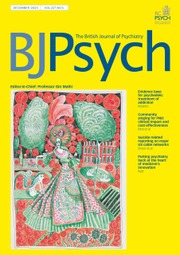No CrossRef data available.
Article contents
When the future escapes: study of the sense of control in predictions about the future over time after exposure to a traumatic event
Published online by Cambridge University Press: 11 April 2025
Abstract
Traumatic experiences can trigger post-traumatic stress disorder (PTSD) and influence one’s future perspective, which can change over time with the sense of control.
We measured changes in predictions about the future among individuals who experienced a traumatic event, with or without PTSD, according to their sense of control, and its relationship with post-traumatic change (post-traumatic stress symptom severity, well-being and coping strategies).
Eighty-one exposed individuals (who experienced the 2015 Paris terrorist attacks), some with PTSD, and 71 non-exposed controls (who had not experienced the attacks) were asked to estimate the probable future occurrence of 20 controllable and 20 uncontrollable events, 7–18 and 31–43 months after the attacks. Repeated-measures analysis of variance and correlations were performed to measure inter-group differences in outcomes and relationships with post-traumatic change.
Exposed participants with PTSD and without PTSD estimated uncontrollable future events to be more likely over time. Uncontrollable predictions were related to increases in post-traumatic stress symptom severity for individuals without PTSD. Uncontrollable predictions were not correlated with well-being or coping in exposed individuals.
Over time, exposed individuals provide increasingly high probability ratings for the future occurrence of uncontrollable events, a tendency associated with an increase in post-traumatic stress symptom severity in exposed individuals without PTSD. This may reflect potential delayed PTSD symptoms over time in individuals who did not initially develop PTSD following the attacks. The range of the measurements and the use of a self-constructed questionnaire limit the internal validity of the results.
- Type
- Original Article
- Information
- Copyright
- © The Author(s), 2025. Published by Cambridge University Press on behalf of Royal College of Psychiatrists




eLetters
No eLetters have been published for this article.